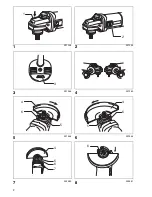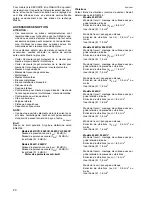
6
2.
Operations such as polishing are not recom-
mended to be performed with this power tool.
Operations for which the power tool was not
designed may create a hazard and cause personal
injury.
3.
Do not use accessories which are not specifi-
cally designed and recommended by the tool
manufacturer.
Just because the accessory can be
attached to your power tool, it does not assure safe
operation.
4.
The rated speed of the accessory must be at
least equal to the maximum speed marked on
the power tool.
Accessories running faster than
their rated speed can break and fly apart.
5.
The outside diameter and the thickness of your
accessory must be within the capacity rating of
your power tool.
Incorrectly sized accessories can-
not be adequately guarded or controlled.
6.
Threaded mounting of accessories must match
the grinder spindle thread. For accessories
mounted by flanges, the arbour hole of the
accessory must fit the locating diameter of the
flange.
Accessories that do not match the mounting
hardware of the power tool will run out of balance,
vibrate excessively and may cause loss of control.
7.
Do not use a damaged accessory. Before each
use inspect the accessory such as abrasive
wheels for chips and cracks, backing pad for
cracks, tear or excess wear, wire brush for loose
or cracked wires. If power tool or accessory is
dropped, inspect for damage or install an
undamaged accessory. After inspecting and
installing an accessory, position yourself and
bystanders away from the plane of the rotating
accessory and run the power tool at maximum
no-load speed for one minute.
Damaged accesso-
ries will normally break apart during this test time.
8.
Wear personal protective equipment. Depending
on application, use face shield, safety goggles
or safety glasses. As appropriate, wear dust
mask, hearing protectors, gloves and workshop
apron capable of stopping small abrasive or
workpiece fragments.
The eye protection must be
capable of stopping flying debris generated by vari-
ous operations. The dust mask or respirator must be
capable of filtrating particles generated by your oper-
ation. Prolonged exposure to high intensity noise
may cause hearing loss.
9.
Keep bystanders a safe distance away from work
area. Anyone entering the work area must wear
personal protective equipment.
Fragments of
workpiece or of a broken accessory may fly away
and cause injury beyond immediate area of opera-
tion.
10. Hold the power tool by insulated gripping sur-
faces only, when performing an operation where
the cutting accessory may contact hidden wiring
or its own cord.
Cutting accessory contacting a
“live” wire may make exposed metal parts of the
power tool “live” and could give the operator an elec-
tric shock.
11. Position the cord clear of the spinning acces-
sory.
If you lose control, the cord may be cut or
snagged and your hand or arm may be pulled into
the spinning accessory.
12. Never lay the power tool down until the acces-
sory has come to a complete stop.
The spinning
accessory may grab the surface and pull the power
tool out of your control.
13. Do not run the power tool while carrying it at
your side.
Accidental contact with the spinning
accessory could snag your clothing, pulling the
accessory into your body.
14. Regularly clean the power tool’s air vents.
The
motor’s fan will draw the dust inside the housing and
excessive accumulation of powdered metal may
cause electrical hazards.
15. Do not operate the power tool near flammable
materials.
Sparks could ignite these materials.
16. Do not use accessories that require liquid cool-
ants.
Using water or other liquid coolants may result
in electrocution or shock.
Kickback and Related Warnings
Kickback is a sudden reaction to a pinched or snagged
rotating wheel, backing pad, brush or any other acces-
sory. Pinching or snagging causes rapid stalling of the
rotating accessory which in turn causes the uncontrolled
power tool to be forced in the direction opposite of the
accessory’s rotation at the point of the binding.
For example, if an abrasive wheel is snagged or pinched
by the workpiece, the edge of the wheel that is entering
into the pinch point can dig into the surface of the mate-
rial causing the wheel to climb out or kick out. The wheel
may either jump toward or away from the operator,
depending on direction of the wheel’s movement at the
point of pinching. Abrasive wheels may also break under
these conditions.
Kickback is the result of power tool misuse and/or incor-
rect operating procedures or conditions and can be
avoided by taking proper precautions as given below.
a) Maintain a firm grip on the power tool and
position your body and arm to allow you to
resist kickback forces. Always use auxiliary
handle, if provided, for maximum control
over kickback or torque reaction during start-
up.
The operator can control torque reactions or
kickback forces, if proper precautions are taken.
b)
Never place your hand near the rotating
accessory.
Accessory may kickback over your
hand.
c) Do not position your body in the area where
power tool will move if kickback occurs.
Kick-
back will propel the tool in direction opposite to
the wheel’s movement at the point of snagging.
d)
Use special care when working corners,
sharp edges etc. Avoid bouncing and snag-
ging the accessory.
Corners, sharp edges or
bouncing have a tendency to snag the rotating
accessory and cause loss of control or kickback.
e) Do not attach a saw chain woodcarving blade
or toothed saw blade.
Such blades create fre-
quent kickback and loss of control.
Safety Warnings Specific for Grinding and Abrasive
Cutting-Off Operations:
a) Use only wheel types that are recommended
for your power tool and the specific guard
designed for the selected wheel.
Wheels for
which the power tool was not designed cannot
be adequately guarded and are unsafe.
Содержание 9561CH
Страница 4: ...4 17 18 19 22 23 014103 007365 010855 8 20 10 21 19 ...
Страница 86: ...86 ...
Страница 87: ...87 ...
Страница 88: ...884674G990 IDE Makita Jan BaptistVinkstraat 2 3070 Belgium Makita Corporation Anjo Aichi Japan www makita com ...







































